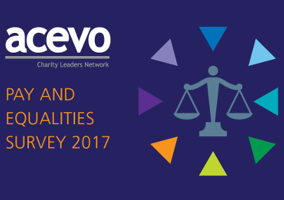Charities, and private companies, with over 250 employees, must publish details of the difference between how much men and women earn on their websites by April 2018.
NCVO estimates that for charities with an income over £500,000 there are 672 which have more than 250 employees. Nearly 300 of these are housing associations, independent schools or universities and the rest are classed as ‘general’ charities.
Regulations on gender pay reporting for the private and voluntary sectors came into force last week and organisations have one year to comply. According to the government 9,000 employers and covers 15 million employees.
Across all sectors the gender pay gap is 18.1 per cent. The gender pay gap is a measure of the difference between average earning for men and women.
Since the Equal Pay Act it has been illegal to pay men and women different salaries for the same job. However women’s groups have argued that the gap in average earnings persists because women are typically expected to take on more caring responsibilities preventing them from taking on the most senior roles.
What employers must publish
By next April employers will need to publish six key figures.
- average gender pay gap as a mean average
- average gender pay gap as a median average
- average bonus gender pay gap as a mean average
- average bonus gender pay gap as a median average
- proportion of males receiving a bonus payment and proportion of females receiving a bonus payment
- proportion of males and females when divided into four groups ordered from lowest to highest pay
They can also publish a narrative to explain what they are doing.
Justine Greening, minister for women and equalities, said: “We have more women in work, more women-led businesses than ever before and the highest proportion of women on the boards of our biggest companies. This has helped us to narrow the gender pay gap to a record 18.1 per cent – but we want to eliminate it completely.
“Helping women to reach their full potential isn’t only the right thing to do, it makes good economic sense and is good for British business. I am proud that the UK is championing gender equality and now those employers that are leading the way will clearly stand out with these requirements.”
Acas has published is guidance and resources for complying with the requirement.
Charities: Pay reporting alone is not enough
NCVO has said that it intends to voluntarily comply with reporting, even though it has fewer than the 250 employees, but said that publishing a figure should be accompanied by other measures to tackle inequality.
Susan Cordingley, director of planning and resources at NCVO, said: “This is a welcome piece of legislation that will be a useful tool for tackling gender inequality in the workplace. To be truly effective, however, it must be complemented by other measures, such as flexible working, part-time roles and shared parental leave, which increasing numbers of voluntary organisations offer to their staff.
“Organisations need to start capturing data now and think about how they can provide a narrative of what the statistics mean for their organisation.
“Although NCVO is not required to comply with the new legislation, as we have fewer than 100 staff, we will be publishing information on pay by gender next April and encourage others to do likewise.”
Women’s groups have also endorsed the new measures, but said that there is still more to do.
Sam Smethers, chief executive at Fawcett Society said: "This is the most significant legal change since the Equal Pay Act and we strongly welcome it. For the first time large employers will be required to calculate & publish their gender pay gap.
"Employers should see it as an opportunity not a threat. Through gender pay gap reporting they can address the productivity gap & get the best person for the job at the right level."
Carole Easton, chief executive of the Young Women’s Trust, said the move was a “great step forward” and that: ““Pay transparency alone will not change the gender stereotypes that often determine the types of roles men and women take and the industries they work in. We need action to support young women into male-dominated areas if we are to close the gender pay gap. Making apprenticeships work for women, including by providing more part-time and flexible apprenticeships to help them balance work and family life, would be a great start.”
From our magazines
Who are the largest charity employers?
The Charity Commission publishes data on the top 100 charities ranked by the number of employees. Those that appear in the top 20 are mostly those that provide services.
Eleven of the top 20 make no reference to gender in their latest annual reports and eight of them do so as part of a statement about their equality or diversity policies.
Part of Oxfam’s programme work includes promoting gender equality around the world and in its annual report it has said that 50 per cent of its staff are female. It also published details of ethnicity.
- Save the Children International – 16,082
- Marie Stopes International – 12,426
- The British Council - 9,624
- Lloyds Register Foundation – 8,892
- Barnardo’s – 8,342
- Mencap - 8,260
- Nuffield Health – 7,984
- United Church Schools Foundation – 6,740
- Anchor Trust – 6,626
- National Trust – 6,211
- Methodist Homes – 6,053
- Cardiff University – 5,510
- Oxfam – 5,238
- Action for Children – 5,143
- Community Integrated Care – 5,137
- Leonard Cheshire Disability – 4,566
- Marie Curie – 4,314
- Halo Trust – 4,111
- International Medical Corps – 3,975
- St Andrew’s Healthcare – 3,761
|
Related articles










